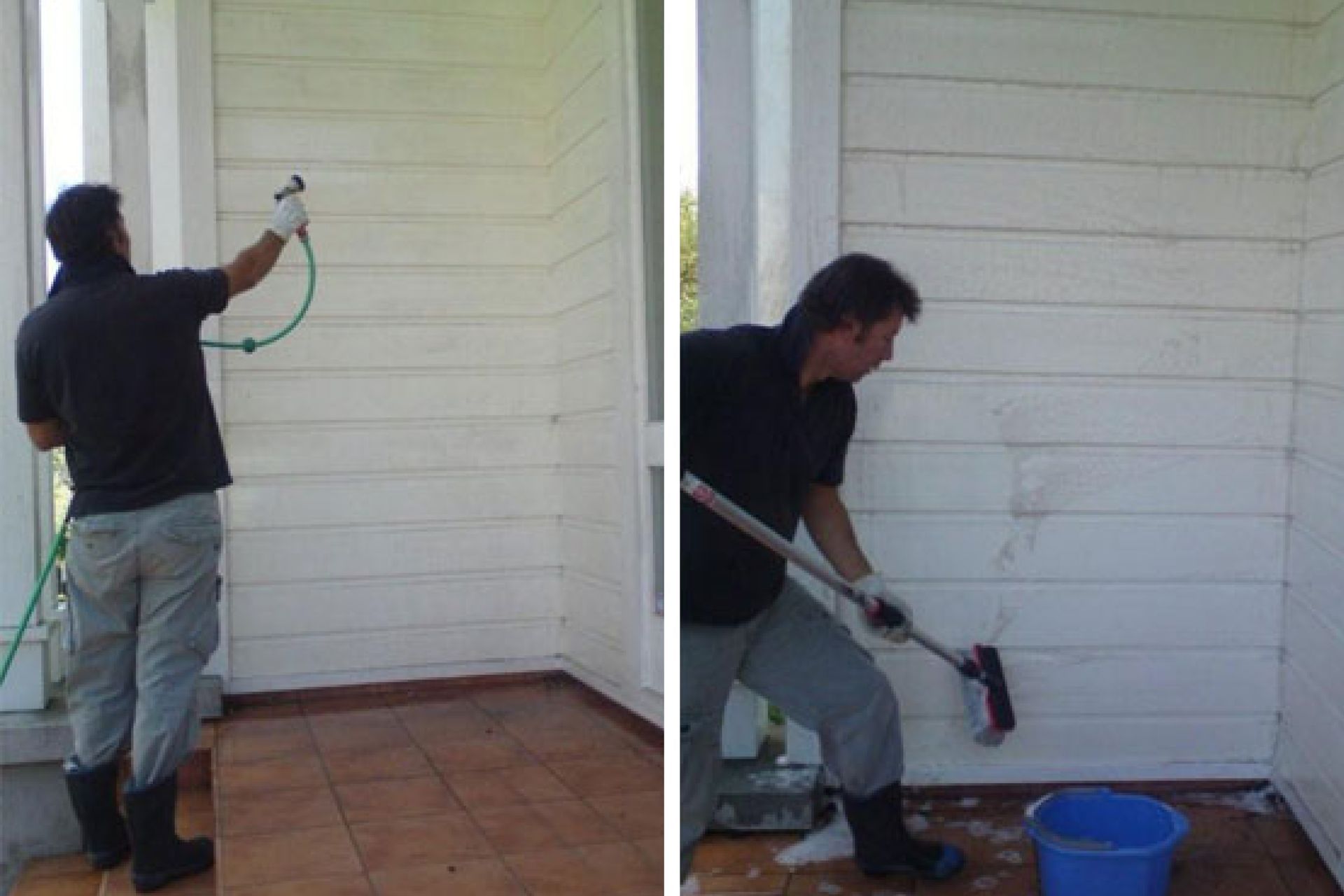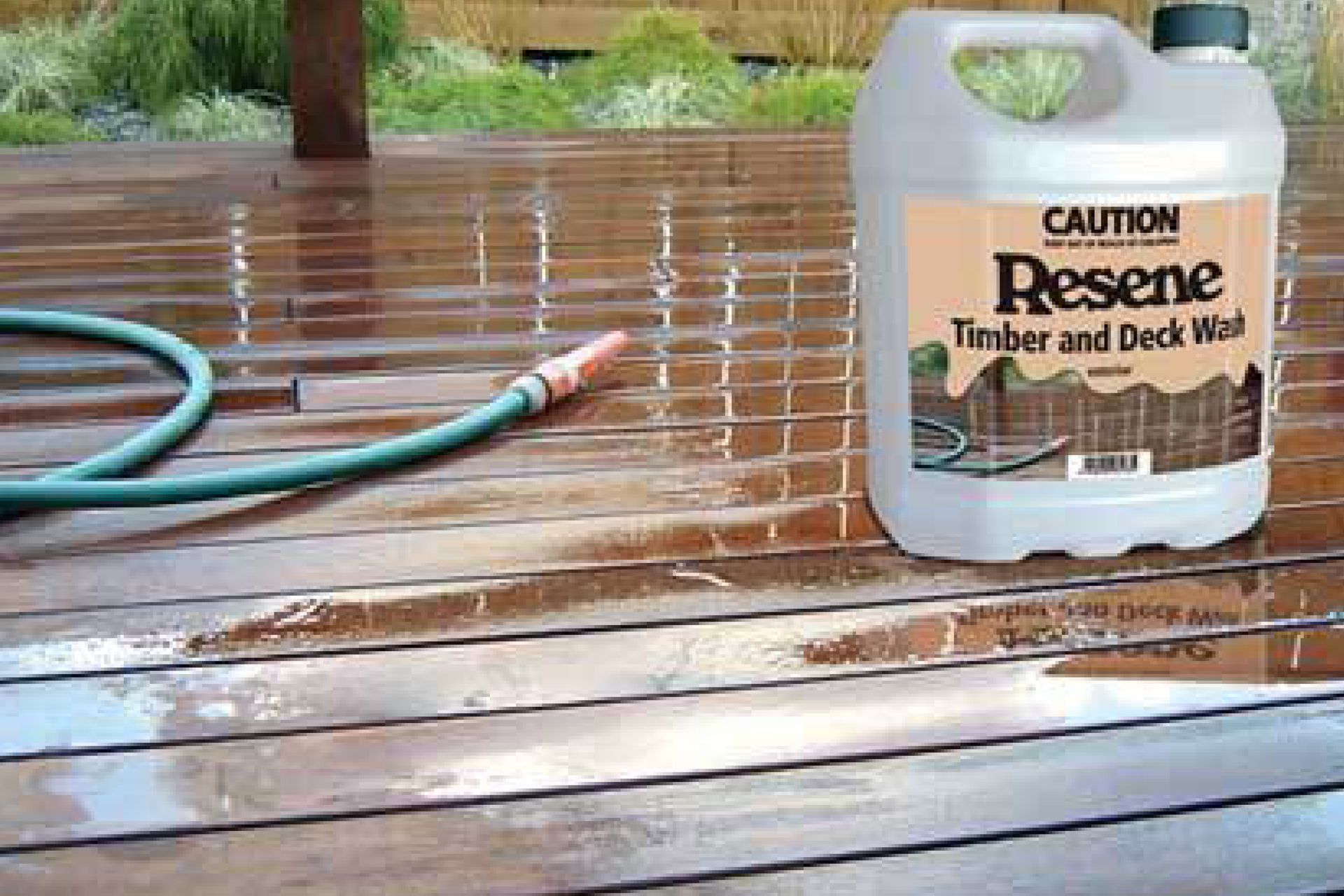Dog days are over, time to prep those decks and weatherboards
Written by
17 February 2021
•
10 min read

Summer is coming to an end, which means it won’t be long until we’re all grumbling about the state of the winter weather and dreaming of the summer just gone and the one that seems so far off.
But, like our forebears, now is not the time for slacking.
Resene Technical Sales Support Manager—Northern Region, Rob Mountford, has some good advice about making sure your timber decks and cladding stand up to the rigours of the New Zealand winter.
ArchiPro: What tips can you give for preparing timber decks and weatherboards for winter?
Rob Mountford: In the colder, wetter months mould and algal growth is much more significant than in the warmer, drier months, with south-facing elevations being more affected than north-facing.
Utilising longer-term cleaners that you only need to spray on and leave—such as Resene Deep Clean—on weatherboards and decks is the simple, safe method of keeping outdoor surfaces free from moss, mould, algae and lichen.
It’s always best to apply these types of cleaners prior to any significant mould and algal growth, as this will allow it to act faster and keep exterior surfaces looking better for longer.
AP: How often should you clean/maintain timber decking and weatherboards?
RM: Airborne contaminants, including salt deposits, which settle on your paint film, can attack the surface and cause premature breakdown. Cleaning of exterior paintwork on an annual basis is recommended in the NZ Building Code and by all paint manufacturers to help maintain the fresh appearance of the paintwork. Areas that are not subject to regular rain washing will benefit from more regular cleaning.
Likewise, without regular cleaning, moss and lichen can penetrate the surface of the paint film, damaging its integrity and reducing the useful life of the film, while mould growth can destroy the chemical entity of the resin system that binds the paint structure together. Existing moss, mould and lichen will retain moisture, further promoting growth of these organisms and increasing the risk of damage to the coating.
To prevent this from occurring, remove any traces of growth using an appropriate washing procedure utilising a cleaner such as Resene Paint Prep and House Wash. This will increase the life of the coating and maintain the aesthetic properties of the paint finish.
The use of slower-acting, longer-term cleaners such as Resene Deep Clean on both decks and weatherboards is the simple, safe method of keeping outdoor areas free from moss, mould, algae and lichen, destroying the growth and combining with nature to let the remains be weathered off leaving a cleaner surface.
Repainting is generally recommended every 8–12 years, while re-staining is recommended every 2–5 summers depending on exposure levels and orientation to the sun—every second summer for north-facing elevations.
AP: What's the best way to maintain the painted finish on weatherboards?
RM: Cleaning of exterior paintwork on an annual basis is recommended to help maintain the fresh appearance of the paintwork, paying special attention to areas that are not subject to regular rain washing.
Generally, painted exterior timber will be in reasonable condition even with some moss and mould on the surface as well as salt, dirt and other contaminants and detritus. It’s a common misconception that waterblasting alone will satisfactorily clean down a surface, however this is not the case. While it will remove some loosely bound surface contaminants it won’t remove surface chalking and other more tightly bound contaminants. Additionally, waterblasting at too high a pressure can easily damage substrates, an issue we see all too often.
The best method of cleaning is to thoroughly scrub down the painted surface using a soft-bristle broom with a solution such as Resene Paint Prep and House Wash and water to remove all surface chalking, dirt, detritus, moss and mould residue, cobwebs and other contaminants. Not only will this clean the surface it will remove surface chalking of the coating, which water blasting does not, it will improve and prolong colour fastness of the paint coating.
Chalking is the process whereby a paint coating slowly breaks down due to UV degradation, leaving a white powdery substance on the surface. This is generally perceived as fading of a paint coating but can often be easily removed with regular cleaning, restoring much of the colour to its former glory. It’s worth noting also that all paint coatings will be affected by UV impact and chalk at varying degrees, depending on quality of paint product used, colours chosen, exposure levels and orientation to the sun and so forth.

AP: What is the best way to prep timber decking and weatherboards prior to painting or staining?
RM: The preparation required for painting most new timber used in New Zealand is fairly straightforward. The key being to ensure the paint is applied to a sound surface and that the timber and any treatments used, are both compatible with the paint system and ready to be primed. For example, if light organic solvent preservative (LOSP) treated timber is used, there should be no residual solvent smell emanating from the timber and the moisture content should be at acceptable levels.
The better the preparation, the better the resulting painted finish will be in terms of appearance and durability. Timber that has been erected in a timely manner and not exposed to UV light and weather, will typically only require construction dirt and other contaminants to be cleaned off before sanding any sharp edges as required. However, if the timber has been left for extended periods of time and /or has moss and mould on the surface, it will need to be treated prior to painting or staining.
New decking—both hardwood like Kwila or softwood such as pine—is, again, relatively straightforward to stain once it has been prepared. The main issue being that when the boards are machined, as part of the manufacturing process the surface becomes hardened and does not accept a stain as readily as weathered decking boards.
To overcome this, we recommend the boards are either scrubbed using a cleaning solution such as Resene Timber and Deck Wash, sanded or left to weather, and then scrubbed to open up the grain. With hardwoods, particularly Kwila, it is recommended that they are weathered for 4–6 weeks before staining, although end grain and if possible the underside should be stained before laying. For new weatherboards and decking, all boards should be envelope-coated prior to installation as per the AS/NZS2311:2017 Guide to the Painting of Buildings. This means they should be completely coated on all sides and any cut ends should also be coated prior to installation. For weatherboards, it is ideal that the first top coat is applied prior to installation.
AP: What is the best paint to use on timber weatherboards?
RM: Weatherboards nowadays are commonly primed or stained in the factory, usually with a high-quality alkyd primer such as Resene True-Prime, which forms the first coat of a subsequent paint system. A quality factory-applied primer will also best deal with any residual LOSP treatment resin acids and waxes on the surface of boards, which can cause issues if using other types of primers.
Modern, water-based, 100-per-cent acrylic coatings are the best option for timber weatherboards. Modern technology provides for toughness, durability and adhesion, combined with superb flow and levelling of a coating. For new weatherboards in good condition full-gloss (Resene Hi-Glo) or semi-gloss (Resene Sonyx 101) options provide an excellent finish, as well as a long-term durable and cleanable finish.
In instances where weatherboards are not in ideal condition, lower-sheen coatings provide a good option for minimising the look of obvious surface, or existing coating, imperfections. All paint coatings should be cleaned and maintained on an annual basis to prolong colour fastness and film integrity.

AP: Are all woods created equal?
RM: No, there are many varied types of wood species and products on the market today. The wide nature of variation translates to a wide nature of quality also, which will have a direct impact on the ongoing durability of the paints or stains applied. Manufacturing processes also play a significant part in the final quality and stability of a product, as do the types of cuts that can be selected, for example, quarter-sawn is more stable than half-sawn.
Dimensional stability in timber also has a big impact on paint coatings, as any movement, cracking, or warping in the timber will cause a subsequent coating failure through no fault of the paint coating. Different types of timber species can have better dimensional stability than others and, in addition, modern treatment processes such as acetylation and TMT (thermally modified timber) can also contribute to improved stability. You should always seek the advice of a timber expert when considering which timber to use for your requirements.
AP: What's the most common mistake people make when working with timber?
RM: The most common issue we see is the desire to use an oil (vegetable-derived and often stated as “natural or organic oils”) or polyurethane product on exterior timber, in an attempt to retain its natural lustre. Due to New Zealand’s extremely high UV levels, both options will fail prematurely and leave clients disappointed with the resulting outcome.
When treating an exterior timber surface with a vegetable-derived oil, there is typically no UV protection provided and the timber substrate will generally silver off quickly, often within months. Vegetable-derived oils also often provide a further food source for mould growth and it’s common to see very early onset of mould growth on exterior timbers treated with this type of oil product.
Similarly, clear film-forming polyurethanes do not perform well in New Zealand’s high UV conditions and are likely to fail prematurely, due to the underlying timber fibre breaking down. This most commonly leads to the requirement to completely strip the coating and recoat with an alternative option, better suited to New Zealand conditions.
Many products on the market in New Zealand are formulated and manufactured in other countries to their conditions and simply do not provide long-term solutions to our unique environment, so always make sure to choose a product that has been specifically formulated for New Zealand conditions.

AP: Composite materials are becoming more and more popular. Are they a good alternative to natural timber?
RM: This is a big question best left to suitably qualified industry experts (which I am not), however, from a paint industry perspective, we are always looking for dimensionally stable substrates to paint or stain. What we do know, is that many of the newer composite products often provide an excellent level of stability, which ultimately translates into prolonged longevity of a paint or stain coating.
AP: What trends are you seeing around timber and timber technology?
RM: We are seeing a big shift towards more timber elements in buildings; from different timber species to different profiles, particularly for structural applications; through the use of engineered timber such as Glulam and LVL beams. Also, the use of panelised products such as CLT in both residential and commercial buildings has increased noticeably in recent years; a factor we see through coating specification requests from architects and specifiers.
The use of timber for structural purposes offers many benefits, however it also presents some issues with exterior maintenance, particularly if the access is limited, that is if the product is located at height, or if a high-maintenance system, such as a stain, is used to finish the panels.
Learn more about prepping timber surfaces.